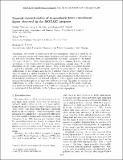| dc.contributor.author | Thouret, Valérie | |
| dc.contributor.author | Cho, John Y. N. | |
| dc.contributor.author | Newell, Reginald E. | |
| dc.contributor.author | Marenco, Alain | |
| dc.contributor.author | Smit, Herman G. J. | |
| dc.date.accessioned | 2017-08-30T19:49:52Z | |
| dc.date.available | 2017-08-30T19:49:52Z | |
| dc.date.issued | 2000-07 | |
| dc.date.submitted | 1999-12 | |
| dc.identifier.issn | 2169-8996 | |
| dc.identifier.issn | 2169-897X | |
| dc.identifier.uri | http://hdl.handle.net/1721.1/111075 | |
| dc.description.abstract | We present a statistical study on tropospheric layers as allowed by the most extensive ozone and water vapor database currently available. Considering O₃ and H₂O deviations from an automatically calculated background, we define four types of layers. These tropospheric layers are a common feature, with the percentage of the troposphere occupied by such layers varying from 7% to 33% depending on the region and the season. Most of the layers are found between 4 and 8 km altitude, and the median thickness is about 500 m. At northern midlatitudes we find 4 times more layers in summer than in winter, while in tropical Asia we observe a spring maximum in the occurrence of the layers. The most abundant layer type everywhere is O₃+H₂O− and corresponds to the signature of stratospheric intrusions or continental pollution. This suggests that stratosphere-troposphere exchanges or at least their influence are not negligible in summer at midlatitudes or in the tropics. A complete understanding of the layers could lead to a better empirical assessment of the different tropospheric ozone sources and to an assessment of the potential vorticity fluxes in the troposphere. | en_US |
| dc.description.sponsorship | National Science Foundation (U.S.) (Grant ATM-9910244) | en_US |
| dc.description.sponsorship | United States. National Aeronautics and Space Administration (Grant NAG1-2173) | en_US |
| dc.language.iso | en_US | |
| dc.publisher | American Geophysical Union (AGU) | en_US |
| dc.relation.isversionof | http://dx.doi.org/10.1029/2000JD900238 | en_US |
| dc.rights | Article is made available in accordance with the publisher's policy and may be subject to US copyright law. Please refer to the publisher's site for terms of use. | en_US |
| dc.source | Cho | en_US |
| dc.title | General characteristics of tropospheric trace constituent layers observed in the MOZAIC program | en_US |
| dc.type | Article | en_US |
| dc.identifier.citation | Thouret, Valérie et al. “General Characteristics of Tropospheric Trace Constituent Layers Observed in the MOZAIC Program.” Journal of Geophysical Research: Atmospheres 105, D13 (July 2000): 17379–17392 © 2000 American Geophysical Union (AGU) | en_US |
| dc.contributor.department | Massachusetts Institute of Technology. Department of Earth, Atmospheric, and Planetary Sciences | en_US |
| dc.contributor.approver | Cho, John Y. N. | en_US |
| dc.contributor.mitauthor | Thouret, Valérie | |
| dc.contributor.mitauthor | Cho, John Y. N. | |
| dc.contributor.mitauthor | Newell, Reginald E. | |
| dc.relation.journal | Journal of Geophysical Research: Atmospheres | en_US |
| dc.eprint.version | Final published version | en_US |
| dc.type.uri | http://purl.org/eprint/type/JournalArticle | en_US |
| eprint.status | http://purl.org/eprint/status/PeerReviewed | en_US |
| dspace.orderedauthors | Thouret, Valérie; Cho, John Y. N.; Newell, Reginald E.; Marenco, Alain; Smit, Herman G. J. | en_US |
| dspace.embargo.terms | N | en_US |
| mit.license | PUBLISHER_POLICY | en_US |
